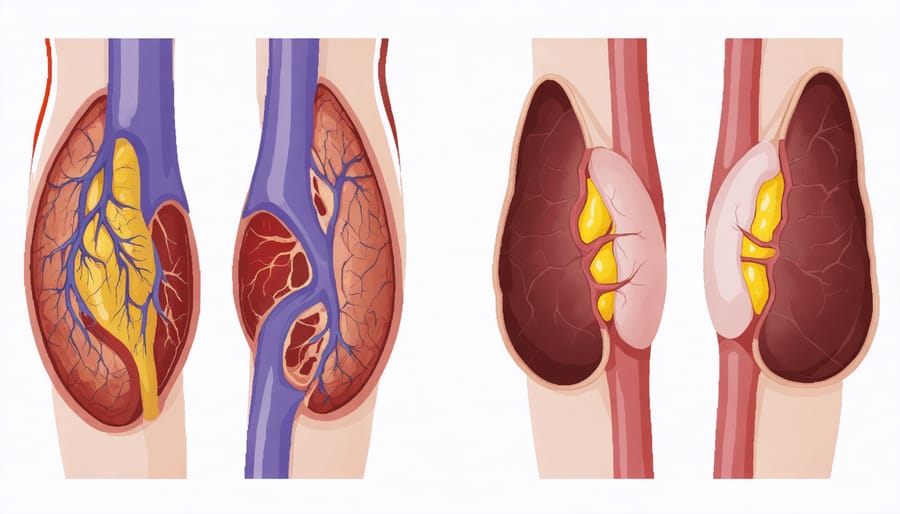The devastating impact of poor dietary habits extends far beyond temporary discomfort – it’s a leading cause of chronic diseases that affect millions of Canadians each year. Making smart food choices today can significantly reduce your risk of developing life-altering conditions like type 2 diabetes, heart disease, and certain cancers. Research consistently shows that diets high in processed foods, refined sugars, and unhealthy fats create a perfect storm of inflammation and metabolic dysfunction in our bodies, setting the stage for long-term health complications. The good news? Many chronic diseases linked to poor nutrition are largely preventable through dietary modifications. Understanding these connections empowers us to take control of our health destiny, making informed decisions about what we put on our plates each day. This article explores the most significant chronic diseases directly impacted by dietary choices, backed by current scientific evidence and practical strategies for prevention through nutrition.

Heart Disease and Poor Dietary Choices
High Blood Pressure and Sodium Intake
High blood pressure, also known as hypertension, affects nearly one in four Canadian adults and is strongly linked to excessive sodium consumption in our daily diet. When we consume too much sodium, our bodies retain more water to maintain proper sodium concentration, which increases blood volume and puts extra pressure on our blood vessels.
The average Canadian consumes about 3,400 mg of sodium per day, which is more than double the recommended daily amount of 1,500 mg. This excess largely comes from processed and packaged foods, rather than salt added during cooking or at the table.
Regular high sodium intake can lead to sustained high blood pressure, which damages blood vessels over time and increases the risk of heart disease, stroke, and kidney problems. The good news is that reducing sodium intake can help lower blood pressure, often within a few weeks.
To reduce sodium intake, try these practical steps:
– Choose fresh, whole foods over processed options
– Read nutrition labels carefully
– Use herbs and spices instead of salt for flavoring
– Cook more meals at home
– Rinse canned vegetables and beans before use
Making these changes gradually can help your taste buds adjust while protecting your long-term health.
Cholesterol Levels and Saturated Fats
High cholesterol levels, particularly when influenced by excessive saturated fat consumption, play a significant role in developing heart disease and other cardiovascular conditions. When we consume too many saturated fats from sources like processed meats, full-fat dairy products, and certain tropical oils, our bodies produce more LDL (often called “bad” cholesterol) than needed.
This excess cholesterol can build up in our arteries, forming plaques that narrow blood vessels and increase the risk of heart attacks and strokes. Research shows that replacing saturated fats with healthier alternatives, such as those found in olive oil, nuts, and avocados, can help maintain healthy cholesterol levels and reduce cardiovascular risk.
The good news is that dietary changes can make a significant difference. Choosing lean proteins, incorporating more plant-based meals, and reading nutrition labels to avoid hidden saturated fats can help manage cholesterol levels naturally. Even small reductions in saturated fat intake can lead to meaningful improvements in heart health over time.
For optimal heart health, health experts recommend limiting saturated fat intake to less than 10% of daily calories while focusing on consuming more heart-healthy fats and fiber-rich foods.
Type 2 Diabetes and Dietary Factors
Sugar Consumption and Insulin Resistance
Excessive sugar consumption is a significant contributor to insulin resistance, a key factor in the development of type 2 diabetes. When we consume large amounts of sugar, our bodies release insulin to help process it. Over time, consistently high sugar intake can cause our cells to become less responsive to insulin, forcing the pancreas to produce more of this important hormone.
This cycle can eventually lead to insulin resistance, where cells no longer respond effectively to insulin’s signals. As a result, blood sugar levels remain elevated, putting stress on various body systems and potentially leading to diabetes. Common sources of excess sugar include sweetened beverages, processed snacks, and refined carbohydrates.
To reduce your risk, consider limiting added sugars in your diet and choosing whole, unprocessed foods instead. Pay attention to food labels, as sugar can hide under many different names. Combining a lower-sugar diet with regular physical activity can help maintain healthy blood sugar levels and reduce your risk of developing insulin resistance and type 2 diabetes.

Processed Foods and Blood Sugar Control
The impact of processed foods on blood sugar control is a crucial factor in the development of chronic diseases, particularly type 2 diabetes. Processed foods often contain high amounts of refined carbohydrates and added sugars, which can cause rapid spikes in blood glucose levels. When consumed regularly, these foods force your body to produce more insulin, eventually leading to insulin resistance.
Common processed foods like white bread, sugary cereals, and packaged snacks are quickly broken down by your body, causing dramatic fluctuations in blood sugar. Over time, this roller coaster effect can overwhelm your body’s natural ability to regulate glucose levels effectively. Research shows that individuals who consume high amounts of processed foods are significantly more likely to develop prediabetes and type 2 diabetes.
To maintain healthy blood sugar levels, consider replacing processed foods with whole, unprocessed alternatives like vegetables, lean proteins, and whole grains. These foods provide steady, sustained energy and help prevent the dangerous blood sugar spikes associated with processed foods.
Obesity-Related Health Complications
Joint Problems and Excess Weight
Excess weight and poor dietary habits can significantly impact your joint health, leading to various joint disorders and chronic pain. When carrying extra weight, your joints – especially knees, hips, and ankles – bear additional pressure with every step you take. For instance, every extra kilogram of body weight adds about 4 kilograms of pressure to your knees during daily activities.
This increased stress on joints can accelerate the breakdown of cartilage, leading to conditions like osteoarthritis. Additionally, fatty tissue produces inflammatory substances that can worsen joint inflammation and pain. The combination of mechanical stress and inflammation creates a cycle that can severely impact mobility and quality of life.
The good news is that even modest weight loss can make a significant difference. Losing just 5-10% of body weight can reduce joint pain and improve function. Adopting a balanced diet rich in anti-inflammatory foods, combined with regular, joint-friendly exercises, can help manage weight and protect joint health for the long term.
Sleep Apnea and Weight Issues
The relationship between poor diet, excess weight, and sleep apnea creates a challenging cycle that can significantly impact overall health. When excess weight accumulates, particularly around the neck and throat area, it can put pressure on airways during sleep, leading to breathing interruptions characteristic of sleep apnea.
Sleep apnea, in turn, can make weight management more difficult. Poor sleep quality disrupts hormones that regulate hunger and fullness, specifically ghrelin and leptin. This hormonal imbalance often leads to increased cravings for high-calorie foods and a slower metabolism, making it harder to maintain a healthy weight.
The good news is that even modest weight loss through improved diet can help reduce sleep apnea symptoms. Research shows that losing just 10% of body weight can significantly improve sleep quality and reduce the severity of sleep apnea. This improvement creates a positive cycle, as better sleep makes it easier to maintain healthy eating habits and stay active during the day.
For optimal results, focus on a balanced diet rich in whole foods, regular physical activity, and maintaining good sleep hygiene.
Cancer Risk and Dietary Patterns
The relationship between diet and cancer risk is well-established through extensive research. Poor dietary habits can significantly increase your risk of developing various types of cancer, particularly those affecting the digestive system and hormone-sensitive tissues.
A diet high in processed meats, such as bacon, hot dogs, and deli meats, has been strongly linked to increased risk of colorectal cancer. The World Health Organization classifies these foods as Group 1 carcinogens, meaning there’s convincing evidence of their cancer-causing potential.
Excessive consumption of red meat, ultra-processed foods, and foods high in added sugars may also contribute to cancer development. These dietary patterns can lead to obesity, inflammation, and hormonal imbalances – all factors that increase cancer risk.
On the other hand, research shows that a diet rich in plant-based foods can help protect against various cancers. Fruits, vegetables, whole grains, and legumes contain powerful antioxidants and other compounds that help fight cancer-causing free radicals and support your body’s natural defense systems.
To reduce your cancer risk through diet:
– Limit processed meat consumption
– Choose lean proteins and plant-based protein sources
– Eat a variety of colorful fruits and vegetables daily
– Include fiber-rich whole grains in your meals
– Reduce intake of ultra-processed foods
– Maintain a healthy weight through balanced nutrition
Remember that dietary changes work best as part of a comprehensive approach to cancer prevention, which includes regular physical activity, maintaining a healthy weight, and avoiding tobacco products.
Preventing Chronic Disease Through Better Nutrition

Building a Balanced Diet
Building a balanced diet is essential for preventing chronic diseases and maintaining overall health. Start by filling half your plate with colorful vegetables and fruits, which provide vital nutrients and antioxidants. Choose whole grains over refined options for fiber and sustained energy. Include lean proteins such as fish, poultry, legumes, and nuts to support muscle health and immunity.
Incorporate healthy fats from sources like avocados, olive oil, and fatty fish, while limiting saturated and trans fats. Keep portions reasonable by using the plate method: half vegetables, quarter protein, and quarter whole grains. Stay hydrated by drinking water throughout the day instead of sugary beverages.
Plan your meals to include a variety of food groups, and prepare most of your meals at home where you can control ingredients and cooking methods. When grocery shopping, focus on whole, minimally processed foods and read nutrition labels carefully. Consider consulting a registered dietitian for personalized advice, especially if you have specific health concerns or dietary restrictions.
Remember that small, sustainable changes to your eating habits are more effective than dramatic short-term modifications. Aim for progress, not perfection, in developing healthy eating habits that can last a lifetime.
Making Sustainable Changes
Making sustainable changes to your healthy eating habits doesn’t have to be overwhelming. Start by making small, manageable adjustments rather than dramatic overhauls. Begin with one change, such as adding an extra serving of vegetables to your daily meals, and build upon your success.
Create a realistic meal planning routine that fits your lifestyle. Stock your kitchen with nutritious staples and prepare healthy snacks in advance to avoid impulsive food choices. Consider batch cooking on weekends to ensure nutritious meals are readily available during busy weekdays.
Build a support system by sharing your health goals with family and friends. Consider working with a registered dietitian who can provide personalized guidance and help you develop sustainable strategies. Track your progress using a food diary or mobile app, but focus on consistency rather than perfection.
Remember that lasting change takes time. If you slip up, don’t get discouraged – view it as a learning opportunity and continue moving forward with your health goals.
The connection between diet and chronic disease is clear and significant. Poor dietary choices can lead to serious health conditions like heart disease, type 2 diabetes, certain cancers, and obesity. However, the good news is that many of these conditions are largely preventable through healthy eating habits. By choosing nutrient-rich whole foods, limiting processed foods and added sugars, and maintaining a balanced diet, you can significantly reduce your risk of developing these chronic conditions. Remember that small, consistent changes to your eating habits can make a big difference in your long-term health. Take control of your well-being today by making informed food choices and creating healthy eating habits that will serve you well into the future. Your diet is one of the most powerful tools you have to protect your health.

